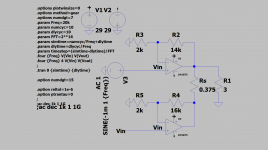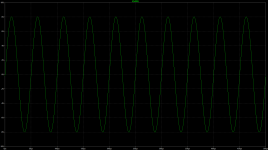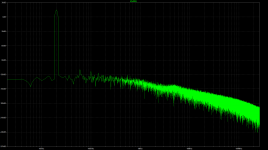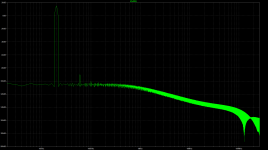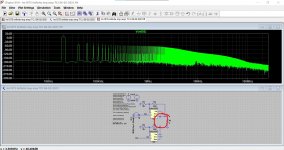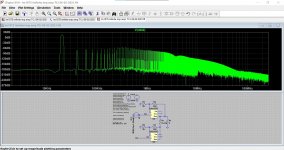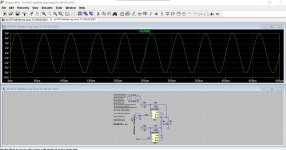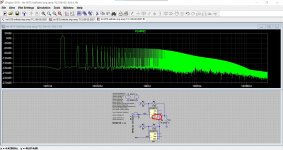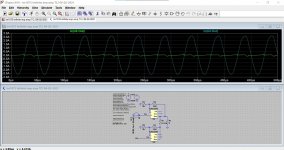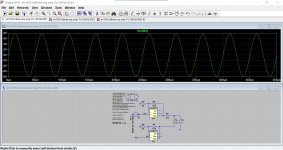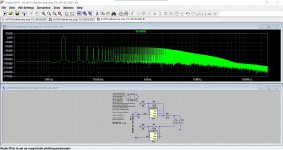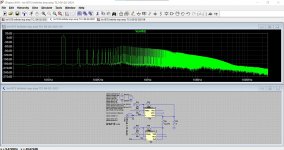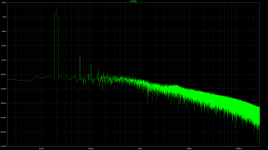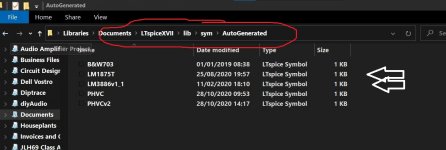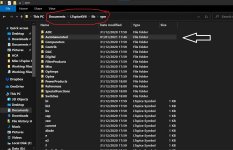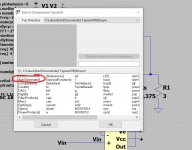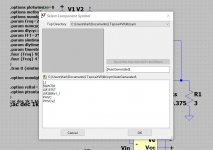Hi!
John Broskie had the idea of such amp for HP driving to make upper amp (tube) seeing infinite impedance of the load: Infinite-Impedance Amplifiers and Crossovers
I tried to use it for speaker driving, sim results attached.
RS is for exact impedance matching, the formula (0.125/0.111-1)*3=0.375 is in linked blog, for 3 Ohm (my Magnepan 1.5) Rs=0,375
However when Rs=4 Ohm THD is much lower (probably because both amps are working and putting the current to the load), you can see it in atachments.
I think achieving so low THD with a few parts is interesting, what do you think?
Not bench tested, but there should be no oscilations due to not too little gain of chip amps.
John Broskie had the idea of such amp for HP driving to make upper amp (tube) seeing infinite impedance of the load: Infinite-Impedance Amplifiers and Crossovers
I tried to use it for speaker driving, sim results attached.
RS is for exact impedance matching, the formula (0.125/0.111-1)*3=0.375 is in linked blog, for 3 Ohm (my Magnepan 1.5) Rs=0,375
However when Rs=4 Ohm THD is much lower (probably because both amps are working and putting the current to the load), you can see it in atachments.
I think achieving so low THD with a few parts is interesting, what do you think?
Not bench tested, but there should be no oscilations due to not too little gain of chip amps.
Attachments
Last edited:
If the top amp sees an infinite impedance, it means it will not deliver any current.
If that is the case, you can delete the upper amp from the circuit and nothing changes.
I tried to run your circuit but I am missing the LM1875.asy and model.
Jan
If that is the case, you can delete the upper amp from the circuit and nothing changes.
I tried to run your circuit but I am missing the LM1875.asy and model.
Jan
Hmmm...
Last shot is the current output of each chip. Not convinced tbh 😉
Edit... I'm reading the scale incorrectly, the distortion is a lot lower connected as intended.
Must try a parallel pair now.
Last shot is the current output of each chip. Not convinced tbh 😉
Edit... I'm reading the scale incorrectly, the distortion is a lot lower connected as intended.
Must try a parallel pair now.
Attachments
If the top amp sees an infinite impedance, it means it will not deliver any current.
If that is the case, you can delete the upper amp from the circuit and nothing changes.
I tried to run your circuit but I am missing the LM1875.asy and model.
Jan
Hi Jan, attached
Attachments
Hmmm...
Last shot is the current output of each chip. Not convinced tbh 😉
Edit... I'm reading the scale incorrectly, the distortion is a lot lower connected as intended.
Must try a parallel pair now.
Dear Mooly,
please zip and post your asy file, thank you in advance!
this means my models are "ideal"?
I missed this post earlier.
Yes, I suspect that is a lot to do with it. I've given my models realistic specs such as current limiting. This is a the LM1875 and LM3886 (single opamp) driving your 3 ohm load.
Going out to play now while its still sunny 😀
Attachments
Here you go. Also in the folder is the symbol and model.
Still doesn't work, the model refers to your standard.bjt .
Jan
Lets try again with the models. I've missed the netlist out.
1/ Download this new Zipped folder
2/ Place the LM1875 and LM3886 folders in the 'Lib' folder located in Documents/LTspiceXVII/Lib
3/ Place the Symbols.
If you already have an 'AutoGenerated folder located in 'Lib/Sym then just copy the symbols to it. If you haven't got the folder then copy the whole folder across.
1/ Download this new Zipped folder
2/ Place the LM1875 and LM3886 folders in the 'Lib' folder located in Documents/LTspiceXVII/Lib
3/ Place the Symbols.
If you already have an 'AutoGenerated folder located in 'Lib/Sym then just copy the symbols to it. If you haven't got the folder then copy the whole folder across.
Attachments
I tried it - very easy process!
Mooly - if you have some interesting components (like more op-amps for example), can you share them too?
Mooly - if you have some interesting components (like more op-amps for example), can you share them too?
These are all I have. A simulated real speaker (My B&W 703's) and two Photo Voltaic Couplers which were a bit of an experiment but they do work. The version 2 seems the better one.
It took me ages to figure out the 'AutoGenerated' procedure for making/saving models so I won't say its easy... but once you know how to do it is.
You can take a whole circuit like a complete amp and make it into a model with just the connections to the outside world showing.
You can also make much fancier symbols and customise them much more.
Post #2272 here:
Installing and using LTspice IV (now including LTXVII). From beginner to advanced.
It took me ages to figure out the 'AutoGenerated' procedure for making/saving models so I won't say its easy... but once you know how to do it is.
You can take a whole circuit like a complete amp and make it into a model with just the connections to the outside world showing.
You can also make much fancier symbols and customise them much more.
Post #2272 here:
Installing and using LTspice IV (now including LTXVII). From beginner to advanced.
Attachments
You can also use the class AA of Technics, one amp works in voltage without current load, the other pouring the current needed at any output impedance.
The LM1875 for best
Your version sees infinity only at a precise resistance, the class AA sees infinity load at any impedance.
In your case if the amp is not loaded, the two amps load each other and consume as class A, the class AA unloaded, doesn't pump any current.
The LM1875 for best
Your version sees infinity only at a precise resistance, the class AA sees infinity load at any impedance.
In your case if the amp is not loaded, the two amps load each other and consume as class A, the class AA unloaded, doesn't pump any current.
Last edited:
You call up the models from here:
Hi Mooly!
thank you but the sim calls for LM1875Tnet file on your harddisk,
and the simulation cannot be performed,
please lift a hint what to do?
- Home
- Amplifiers
- Solid State
- Infinite impedance amplifier idea J Broskie
